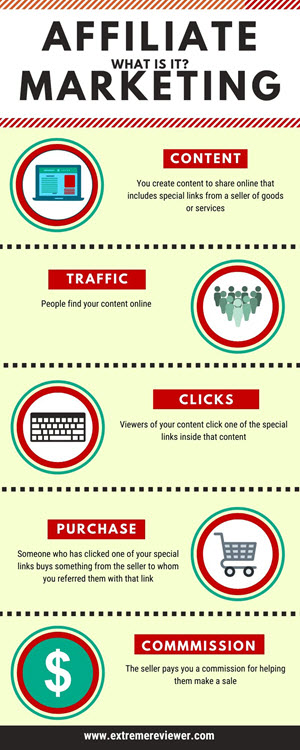
In 2009 I was traveling heavily for my job. I was spending a lot of time alone in a hotel room with nothing much to do.
I decided I’d try learning HTML with the goal of building a family website where my parents, siblings, nieces and nephews could all stay in touch (oh, hello, Facebok!). I figured it would give me something to do with all that downtime.
While reading up on HTML and website building I kept coming across a term I hadn’t heard before – affiliate marketing.
I’d glossed over the reference several times but as it kept coming up in article after article having to do with website building it seemed important.
I realized that these articles were talking about ways to make money with a website and while that wasn’t at all what I had set out to do once the idea was in my head it was hard for me to ignore.
People were talking about making money not from businesses I’d never heard of before but from big companies like Amazon.
I thought I was pretty business savvy but this type of arrangement was completely foreign to me.
Ten years of experience later and it makes a lot more sense.
If I knew then what I know now I could have seen better results more quickly.
A thorough explanation of affiliate marketing can help you get started on the right foot and save you a lot of frustration and wasted time.
When I first started I didn’t think about the intricate connections between the moving parts (and it turns out they’re important).
I only understood the overall concept:
Affiliate marketing is the act of promoting the products created by others in exchange for a share of any sales generated (a commission).
The word “promote”, in this context, doesn’t mean you’re out there going door to door making sales pitches.

Affiliate marketers create content (website posts, videos, emails, PDFs, social media posts) that includes special links (affiliate links) that they’ve obtained from product sellers and share that content with an audience that might be interested in the product or services offered by the sellers.
If viewers of that content click one of those special links and buy something from the seller then the creator of the content (the affiliate marketer) may receive compensation.
It is a marketing strategy used by businesses to increase sales.
The products that affiliates promote can be digital (like ebooks), physical (like goods sold on Amazon), or service related (like graphic design services).
As consumers, we are familiar with other kinds of marketing strategies like ads on television or in magazines.
Businesses buy space on those types of mediums so that they can expose their brand to large audiences. They often pay a flat fee for this type of ad but it’s difficult to determine the specific volume of sales that were generated from that kind of advertising.
Affiliate marketing is a more targeted advertising approach and the seller only pays out when a desired action takes place (a sale).
It is also a data-rich strategy because the seller can tell which content and which affiliate drove a specific sale.
In a nutshell, affiliate marketing is designed to help businesses tap into an important sales tool – social proof.

If you walk into a store and a salesperson tells you why you should buy this one kind of television, aren’t you always a little doubtful of any claims they make?
We’ve become leery of believing everything said by someone who has a vested interest in us buying what they’re pitching.
But if someone you trust tells you a product is a good deal you are more likely to believe them.
People also like to mirror the styles and behaviors of other people when they’re not sure what is hot, trendy, in or cool. If they trust that person, they are more likely to buy what they are recommending.
Affiliates can establish trust through the content they create. I bet there are blogs you read regularly because you like the topic, style, and quality of information shared by the blogger.
If that blogger told you that they recommend you buy x product and it was something you could use you might actually buy that item based solely on the blogger’s opinion because you trust them.
What you might not have realized was that the blogger was getting some form of compensation for having recommended that product which makes that recommendation more like an advertisement (which is why the FTC wants bloggers to be more transparent about the existence of affiliate links inside content).
Using affiliates, sellers can have an army of content creators on the web recommending their products, helping them build their brand and helping them make more sales all without having to pay traditional wages.
TERMINOLOGY
Common Words & Phrases
Before we get into a description of the work, it’s necessary to understand some of the terminology related to the field.
Affiliate (aka Affiliate Marketer, Publisher or Partner)
A content creator who has a relationship with at least one seller that allows them to include special links inside their content in exchange for compensation for any sales generated from those links.
Affiliate Link (aka Special Link)
A unique website link provided by the seller to an affiliate for use in the affiliate’s content.
Many sellers provide affiliates multiple special links with each leading to a different page of the seller’s website.
Affiliate Marketing Website
A website built for the purposes of publishing content that includes affiliate links.
Affiliate Network
A management company that facilitates the affiliate programs of a collection of retailers. Some sellers want the benefits of using affiliates without having to manage the actual tracking and payment detail.
In those cases, the seller can engage an affiliate network to manage their program on their behalf.
Affiliates who want to work with those merchants apply to the network first and then, individually, to the affiliate programs of any seller in that network.
Affiliate Program
A retailer’s plan for the use of and payment to affiliates.
Clicks
The number of times an affiliate link has been clicked. An affiliate has the opportunity to receive a commission if a sale is made after a viewer of their content has clicked an affiliate link.
Therefore, getting a click on such a link is an important part of the process. Tracking the volume of clicks can provide signals to the affiliate about changes they may need to make in order to improve their results.
Click Through Rate (aka CTR)
The number of viewers who click an affiliate link compared to the total number who viewed the link. Not all viewers of an affiliate link click on the link.
Calculating and tracking the percentage of viewers who do click a link can provide an affiliate with more clues about ways they can improve their performance.
Commission (aka Commission Rate)
The amount the seller agrees to pay to an affiliate when a sale is made.
This is usually expressed as a percentage or a flat dollar amount.
Commission Bump
An increase in the standard commission.
A seller may offer a higher commission to affiliates who outperform the norm or during special advertising or seasonal events.
Content
Material created by an affiliate in which an affiliate link will be placed.
There are many kinds of content affiliates can create:
- Posts or articles published on websites owned by the affiliate
- Posts or articles published to websites not owned by the affiliate (YouTube, Pinterest, Instagram, Facebook, related forums, user-generated content sites, membership sites)
- Emails
- PDFs
- Ebooks
- Spreadsheets
- Software
- Mobile apps
Not all merchants allow their links to be placed on all forms of content.
The terms of each seller’s affiliate program outline which forms of content are acceptable to them.
Conversion Rate
The number of people who clicked an affiliate link and made a purchase compared to the total number of people who clicked the affiliate link.
Not all people who click an affiliate link purchase something from the seller. Understanding the percentage that do is another way affiliates can gauge the success of their business.
Cookie Length
The amount of time between a content viewer clicking on an affiliate link and the content viewer making a purchase for which the retailer is willing to credit the affiliate for the sale.
Sellers decide the cookie length for their program. These are usually set at a number from 24 hours to 90 days although there are exceptions.
If an affiliate program has a 30 day cookie length then the affiliate can earn a commission on purchases made within 30 days of someone clicking on an affiliate link for that program.
Earnings per Click (aka EPC)
The average amount of commissions earned per single click on an affiliate link. This number has several uses. An affiliate may track the EPC they are personally achieving from the traffic to their content.
This allows them to compare the earnings from competitive affiliate programs and determine which is best for them.
Merchants may also calculate the EPC experienced by their affiliates in total and share that information so that prospective affiliates can judge the profit opportunity of participating in a merchant’s program.
Impressions
The number of times an affiliate link has been viewed.
Niche
The topic around which an affiliate focuses their content.
If you blog about woodworking then your niche is woodworking.
Payment Period
The maximum amount of time between the date an affiliate sale is made and the commission payment is paid to the affiliate.
Some programs pay an affiliate immediately while others – usually those involving physical products – wait until after a refund period has passed.
If a purchased product is returned by the buyer to the seller and a refund is issued, no commission is paid to the affiliate.
Structuring a payment period that allows for refund periods to expire before affiliates are paid ensures that a seller will not have to go back to the affiliate to collect an over-payment of a commission.
Refund Period
The period of time a retailer allows consumers to return purchased products.
Refund Rate
The percentage of a retailer’s sales that are returned for a refund.
If a merchant shares this information then prospective affiliates can use it to decide which programs offer the lowest risk of returned products and avoid those with refund rates that would result in a lower return on the affiliates invested time.
Seller (aka Retailer, Advertiser, or Merchant)
A seller of goods or services.
Terms (aka Operating Agreement)
A retailer’s rules guiding the activities of its affiliates.
Tracking Cookie
A piece of code embedded on the browser of a person who clicks an affiliate link.
It is used to store information about the link including the date and time of the click and the identity of the affiliate to whom the link belongs so that the retailer can track timing and purchase activity related to that click.
Tracking ID
The unique characters within an affiliate link that provide the merchant with the identity of the affiliate to whom that link was assigned.
Traffic
The people who visit your website.
WHAT DOES AN AFFILIATE MARKETER DO?
Job Description
An affiliate marketer earns commissions by creating content that draws attention to a seller’s products or services.
I mentioned above the types of content one can create but not how that content can be used to encourage sales.
Content can:
- Compare the details of competing products to better help a consumer choose between the two
- Prepare a consumer to be comfortable buying from a business they have not heard of before
- Highlight businesses or products consumers might not have found on their own
- Show consumers how to use a product in a new way
- Educate a consumer on the right products to use to solve a problem
- Instruct a consumer how to complete a desired task with recommendations for the best products to use for that task
- Provide a thorough review of a product in order to help consumers make a well-informed buying decision
- Validate the integrity of a seller or the quality of a product
- Provide product selection tools that assist consumers in finding the right products for their needs
You don’t have to be a salesperson to be successful but thinking like your target consumer CAN help you see far better results.
Suppose you run a fashion website and you’ve found an online jewelry store that has an affiliate program. You sign up to become their affiliate and find five beautiful, black onyx rings. You decide to write a post about those items for your website.
Maybe you write some paragraphs about why you liked these rings and then you show images of the five rings with an affiliate link for each one.
A consumer comes across your website, sees the rings but when they click on the link for one and arrive at the jewelry store’s website they’re uncomfortable making a purchase because they’ve never heard of this company before or think the website looks shady or untrustworthy.
The consumer leaves the website and looks elsewhere online for a black onyx ring and you lose out on a commission.
In another example, a consumer clicks on your affiliate link and does buy one of the rings but then returns it because it was poor quality.
What could you, the content creator, have done differently to better pave the way for a successful sale to take place?
You could have:
- Analyzed the look of the jewelry store’s site to make sure you found it trustworthy before promoting the store
- Purchased from the store yourself to test the quality of the products and the customer experience
- Conducted more research about each of the rings in order to answer consumer questions not addressed by the retailer’s site
- Checked the jewelry store’s average return rate before deciding to promote them (a high rate of return signifies high customer dissatisfaction with the products or services offered by a business)
- Purchased all five rings featured in your post, taken images of them on your hand and featured those images in your post to show consumers what the rings look like when worn (particularly if the online store isn’t already providing an image like that)
Affiliates do NOT have to take these extra steps but those who do should see higher sales volumes and commissions.
The job of an affiliate marketer then becomes not just about creating content but also involves research, analysis, influencing, creative thinking, and writing.

As with any kind of job there is work that one does to earn the associated income.
An affiliate earns their commissions from doing the above kinds of tasks.
Again, like other jobs, the income is higher when the job requires more effort, skill, or time. The affiliate commission rate is usually higher when the seller knows that it will take more effort to make a sale.
Amazon is a little unique in this space because a larger share of people who are sent to Amazon are likely to buy something even if they are not influenced by you to do so.
Consumers are extremely comfortable with Amazon and they have an extremely large product offering.
Send a consumer over to the Amazon site and even if that consumer doesn’t buy the product you promoted on your website with an affiliate link they may be reminded – simply by being on the Amazon site – about something else they meant to buy but have neglected or forgotten to order until landing on the site.
That’s why, in my opinion, it’s one of the best affiliate programs for beginners.
If you send people to Amazon, a company they’ve probably already purchased from before, they’re going to be comfortable buying something else from them. An affiliate doesn’t have as much work to do to prep the consumer to be willing to buy from Amazon.
But it’s also why the Amazon Associate program offers lower commission rates and a much shorter cookie length than many other affiliate programs. They know there is less work required on your part in order to drive a sale.
Promoting the products and services of other sellers can be more challenging and require more work but, in exchange, you can earn more money.
WHO CAN BECOME AN AFFILIATE MARKETER
Age & Geographic Limitations
Most people 18 and over can become an affiliate marketer.
You don’t apply the same way as you do for a regular job. Instead, you complete an online application on the retailer’s site or through an affiliate network and provide your personal information, information about how you’d like to be paid (available options are determined by the affiliate program owner), and tax information.
Some affiliate programs require you already have your own website up and running while others do not.
Because of the ease of entry, it’s an attractive opportunity for anyone looking for extra income or to supplement retirement income.
Some countries have various exclusions and some states in the US have limited affiliate programs available to them because of nexus tax laws (although this shouldn’t stop anyone in the US as the available merchant pool is still very large and centered around big box stores like Walmart and Home Depot).
REQUIRED SKILLS
Experience and traits that can be useful
There are a number of skills that can help you be more successful more quickly.
Being able to write is one such skill. You don’t have to be a tremendous fiction writer. Most writing done for affiliate posts is factual or personal in nature which should make the writing a little easier.
Having some experience operating a computer is also handy. You don’t need to be a programmer but you will need to be comfortable learning how to use blogging software like WordPress. Fortunately, most blogging tools these days are very user-friendly and shouldn’t be too challenging to master.
If you’ve never done this work before it’s going to take some time to learn. You don’t need to be an expert in order to start but you should have a willingness to learn new things.
RISKS
Every business has them
As with any income model there are risks but if you take action to prepare yourself in advance they’re pretty minimal.
Legal
There are rules in most countries meant to protect consumers and affiliate marketers need to abide by those rules.
In the US, for example, the FTC expects that affiliate links clearly be identified as such.
You may want to consult with an attorney before getting started to make sure you understand your requirements under any applicable laws and any terms and conditions of the affiliate programs in which you plan to participate.
Zero, Low, or Inconsistent Income
When first starting out you may spend many months working at creating content and not earn a dime.
You might not ever earn any money at all.
There may also be times of the year when sales of the products you choose to promote are slower than other times of the year resulting in gaps between paydays or large differences in your income month to month.
Loss of Income
A seller’s change to their affiliate commission rate, a change to a law in your area, or a change in Google’s search algorithm could result in a loss of income to an affiliate.
You are not limited to promoting just one affiliate program so always have a backup or two on hand that include the kinds of products you’d want to promote. Stay up to date on current laws in your are that govern the activities of affiliate marketers.
Taxes
Since affiliate marketers are not employees of the seller they are responsible for reporting their affiliate income and paying the taxes on those amounts.
You may want to discuss your plan with a tax accountant so that you know which kinds of records you should be keeping for tax time. If you don’t set money aside to pay taxes on your commissions you could end up paying additional fines or fees.
REWARDS
The positives
Relative to many income models the risks are minor compared to the rewards.
Supplemental Income
You could add to your current income.
I have family members who work full time jobs and have side jobs or small businesses they run in order to cover extra costs like college for their children or nicer family vacations.
I also know people who are in retirement and looking for a way to increase their income in order to cover medical bills, build up their savings for the future, or to afford a nicer quality of life.
Income Replacement
Based on personal experience, it is possible to replace one’s income with money made as an affiliate marketer.
It is NOT easy and can take as much as a year or more depending on a large number of factors. It is not something that can happen overnight.
Freedom
If you can build up your affiliate income sufficiently to replace your existing income you can benefit from more flexibility in your schedule. You become your own manager.
Low Barrier to Entry
The cost to getting started can be as low as $0 although owning your own website can greatly increase the number and type of affiliate programs to which you can be accepted.
A domain name and hosting can cost as little as $3.00 per month.
There are many resources online to help understand the business and improve your results.
Applying to an affiliate program is (usually) free and does not require a resume or proof of experience.
IS IT PASSIVE INCOME?
Not really
I have seen people describe affiliate marketing as “passive” income suggesting that you do not have to do any work to maintain this kind of income source.
That is not exactly accurate.
It takes effort to get started. It may be months (even a year or more) before you may see your first commission.

A lot depends on how much you want it (how truly committed you are) and how well you research the right steps to follow.
If you’re operating without a plan to follow it will take you more time to see success.
Once you reach a point where you have a consistent monthly amount coming in you may be able to ease off a bit and it is possible to take stretches of time – months, even – away from your content and it can still receive traffic and make sales. During those periods the income could be defined as passive.
This ability to take time away depends, though, on the types of content you use. If you are publishing posts on a website and relying only on free traffic from Google search results you may see posts decline in search results as they age.
Lower rankings in search results brings in less traffic which results in fewer sales.
Therefore, at least some amount of work and maintenance could be required on a regular basis in order to maintain your results and even greater effort may be necessary in order to grow those results.
HOW TO GET STARTED
Study, follow and practice
I, personally, got started by following a how-to guide I’d found online. This provided me a step-by-step set of instructions I could work through.
I began promoting the Amazon Associate program and then used the skills I learned to promote other programs that were paying higher commission rates, too.
There are lots of little, frustrating tasks to figure out when you first begin.
You need to choose a topic (a niche) to focus on, choose a domain name, build a website, learn how to use your chosen blogging software, write posts, apply to affiliate programs, learn how to put your affiliate links in your content, and how to get traffic to your website.
>> GET EVERYTHING YOU NEED TO GET STARTED WITH MY AZON BREEZE PRODUCT <<
If you already have a website then all you need to do is to apply to the affiliate program of a merchant who sells products related to the topic of your website (or apply to an affiliate network that offers more than one merchant to promote).
Once you’re accepted you’re ready to add your special links to your site.
You can do that by going back through old posts and updating them to include links to products mentioned in those posts, by adding new posts to your site designed around products available from your program, or even by putting a simple banner provided by the merchant’s program in the sidebar of your site.
Then start learning how to read the reports available to you for your important content, your website, and your affiliate activity so you can understand where you have opportunity for growth.
When you fully understand the concepts behind affiliate marketing, why it’s advantageous to sellers, how to think like a consumer, and how to use data to guide your work you can then make changes to your overall approach that will super-charge your results.
